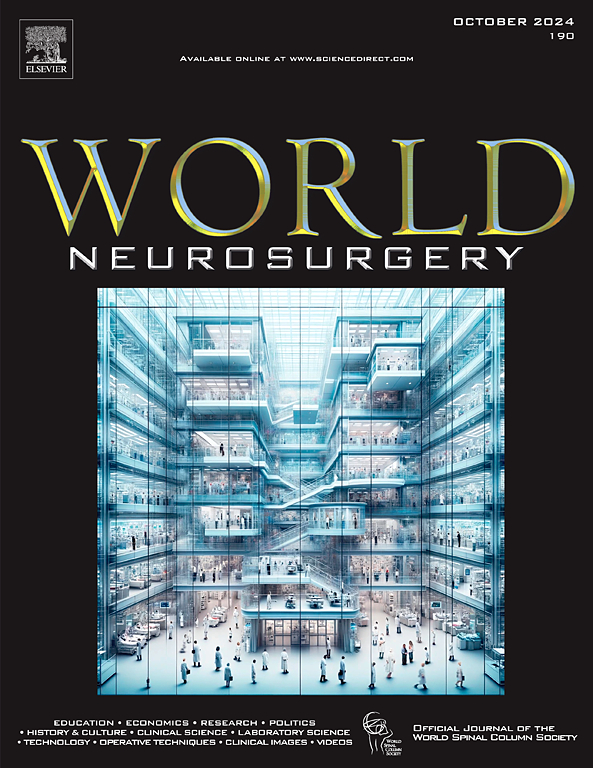Clinical Application of Artificial Intelligence in Prediction of Intraoperative Cerebrospinal Fluid Leakage in Pituitary Surgery: A Systematic Review and Meta-Analysis
IF 1.9
4区 医学
Q3 CLINICAL NEUROLOGY
引用次数: 0
Abstract
Background
Postoperative cerebrospinal fluid (CSF) leakage is the leading adverse event in transsphenoidal surgery. Intraoperative CSF (ioCSF) leakage is one of the most important predictive factors for postoperative CSF leakage. This systematic review and meta-analysis aimed to evaluate the effectiveness of artificial intelligence (AI) models in predicting ioCSF.
Methods
Literature records were retrieved on June 13, 2024, using the relevant key terms without filters in PubMed, Embase, Scopus, and Web of Science. Records were screened according to the eligibility criteria, and the data from the included studies were extracted. The quality assessment was performed using the Quality Assessment of Diagnostic Accuracy Studies–2 tool. The meta-analysis, sensitivity analysis, and meta-regression were conducted using R software.
Results
Our results demonstrate that the AI models achieved a pooled sensitivity of 93.4% (95% confidence interval [CI]: 74.8%–98.6%) and specificity of 91.7% (95% CI: 75%–97.6%). The subgroup analysis revealed that the pooled sensitivities in machine learning and deep learning were 86.2% (95% CI: 83%–88.8%) and 99% (95% CI: 93%–99%), respectively (P < 0.01). The subgroup analysis demonstrated a pooled specificity of 92.1% (95% CI: 63.1%–98.7%) for machine learning and 90.6% (95% CI: 78.2%–96.3%) for deep learning models (P = 0.87). The diagnostic odds ratio meta-analysis revealed an odds ratio 114.6 (95% CI: 17.6–750.9). The summary receiver operating characteristic curve demonstrated that the overall area under the curve of the studies was 0.955, which is a considerable performance.
Conclusions
AI models have demonstrated promising performance for predicting the ioCSF leakage in pituitary surgery and can optimize the treatment strategy.
人工智能在垂体手术术中脑脊液漏预测中的临床应用:系统回顾与元分析》。
背景术后脑脊液(CSF)漏是经椎体手术(TSS)中最主要的不良事件。术中脑脊液(ioCSF)漏是术后脑脊液漏最重要的预测因素之一。本系统综述和荟萃分析旨在评估人工智能(AI)模型在预测ioCSF方面的有效性。方法于2024年6月13日在PubMed、Embase、Scopus和Web of Science中使用相关关键词检索文献记录,不加过滤。根据资格标准对记录进行筛选,并提取纳入研究的数据。采用 QUADAS-2 工具进行质量评估。结果表明,人工智能模型的集合灵敏度为 93.4%(95% CI:74.8%- 98.6%),特异性为 91.7%(95% CI:75%- 97.6%)。亚组分析显示,ML 和 DL 的集合灵敏度分别为 86.2% (95% CI: 83%- 88.8%) 和 99% (95% CI: 93%- 99%) (P<0.01)。亚组分析表明,ML 模型的集合特异性为 92.1%(95% CI:63.1%- 98.7%),DL 模型的集合特异性为 90.6%(95% CI:78.2%- 96.3%)(P= 0.87)。DOR荟萃分析显示,几率比(OR)为 114.6(95% CI:17.6- 750.9)。结论AI 模型在预测垂体手术中 ioCSF 渗漏方面表现良好,可优化治疗策略。
本文章由计算机程序翻译,如有差异,请以英文原文为准。
求助全文
约1分钟内获得全文
求助全文
来源期刊

World neurosurgery
CLINICAL NEUROLOGY-SURGERY
CiteScore
3.90
自引率
15.00%
发文量
1765
审稿时长
47 days
期刊介绍:
World Neurosurgery has an open access mirror journal World Neurosurgery: X, sharing the same aims and scope, editorial team, submission system and rigorous peer review.
The journal''s mission is to:
-To provide a first-class international forum and a 2-way conduit for dialogue that is relevant to neurosurgeons and providers who care for neurosurgery patients. The categories of the exchanged information include clinical and basic science, as well as global information that provide social, political, educational, economic, cultural or societal insights and knowledge that are of significance and relevance to worldwide neurosurgery patient care.
-To act as a primary intellectual catalyst for the stimulation of creativity, the creation of new knowledge, and the enhancement of quality neurosurgical care worldwide.
-To provide a forum for communication that enriches the lives of all neurosurgeons and their colleagues; and, in so doing, enriches the lives of their patients.
Topics to be addressed in World Neurosurgery include: EDUCATION, ECONOMICS, RESEARCH, POLITICS, HISTORY, CULTURE, CLINICAL SCIENCE, LABORATORY SCIENCE, TECHNOLOGY, OPERATIVE TECHNIQUES, CLINICAL IMAGES, VIDEOS
 求助内容:
求助内容: 应助结果提醒方式:
应助结果提醒方式:


